Liste der größten Objekte im Sonnensystem
Dies ist eine Rangliste von großen Objekten im Sonnensystem in absteigender Ordnung. Meist korrelieren Durchmesser und Masse der Objekte sehr stark. Es gibt jedoch Ausnahmen wie Neptun, der zwar eine größere Masse, aber einen kleineren Durchmesser als Uranus hat. Der Planet Merkur ist kleiner, aber massereicher als die Monde Ganymed und Titan.
Liste
Die Zeile jedes hier gezeigten Satelliten hat dieselbe Farbe wie der Planet bzw. Zwergplanet, den dieser umkreist. Von Mars, Haumea, Makemake und Eris besitzt kein Satellit die ausreichende Größe, hier aufgelistet zu werden; Merkur und Venus besitzen nicht einmal Monde. Der Zwergplanet Ceres (ebenfalls mondlos) wird mit derselben Farbe wie die Asteroidengürtel-Objekte ohne Zwergplanetenstatus dargestellt.
Bei einigen transneptunischen Objekten (TNOs) besteht noch eine große Unsicherheit bezüglich Durchmesser, Masse und Albedo. Entsprechend können sich diese Werte bei veränderter Quellenlage erheblich verändern. Planet Neun kann nicht in der Liste geführt werden, da es sich dabei bisher nur um eine Hypothese handelt, ein Beweis für die Existenz dieses Planeten gibt es bisher nicht.
| Rang Ø | Name | Bild | Durchmesser (km) |
Masse (kg) |
Rang Masse | Dichte (g/cm³) |
Objekttyp |
|---|---|---|---|---|---|---|---|
| 1 | Sonne[1] | 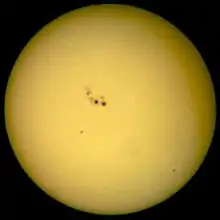 |
1392000 | 1.989e30 | 1 | 1,408 | Stern |
| 2 | Jupiter[1] | 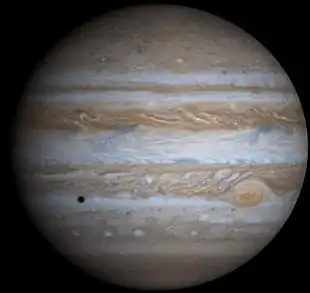 |
|
1.898e27 | 2 | 1,326 | 5. Planet |
| 3 | Saturn[1] | _large_rotated.jpg.webp) |
|
5.683e26 | 3 | 0,687 | 6. Planet |
| 4 | Uranus[1] |  |
|
8.681e25 | 5 | 1,271 | 7. Planet |
| 5 | Neptun[1] | 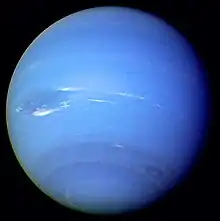 |
|
1.024e26 | 4 | 1,638 | 8. Planet |
| 6 | Erde[1] | 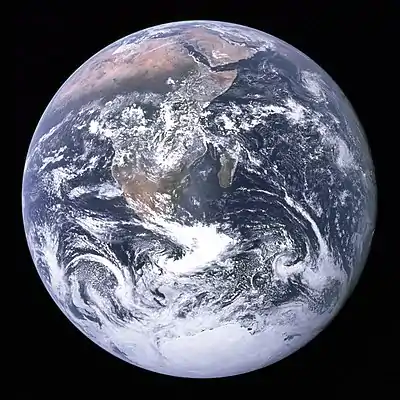 |
|
5.972e24 | 6 | 5,514 | 3. Planet |
| 7 | Venus[1] |  |
12104 | 4.868e24 | 7 | 5,243 | 2. Planet |
| 8 | Mars[1] | 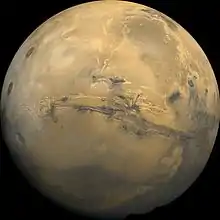 |
|
6.417e23 | 8 | 3,933 | 4. Planet |
| 9 | Ganymed[1] | 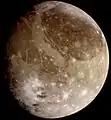 |
5.262 | 1.482e23 | 10 | 1,940 | Jupitermond |
| 10 | Titan[1] | 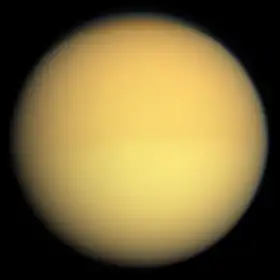 |
5.150 | 1.346e23 | 11 | 1,880 | Saturnmond |
| 11 | Merkur[1] |  |
4.879 | 3.301e23 | 9 | 5,427 | 1. Planet |
| 12 | Kallisto[1] | 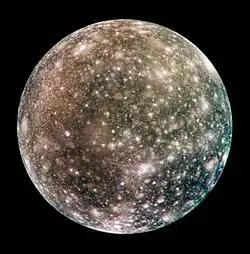 |
4.821 | 1.076e23 | 12 | 1,830 | Jupitermond |
| 13 | Io[1] | 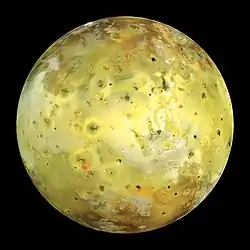 |
3.643 | 8.932e22 | 13 | 3,530 | Jupitermond |
| 14 | Mond[1] |  |
3.476 | 7.346e22 | 14 | 3,344 | Erdmond |
| 15 | Europa[1] | 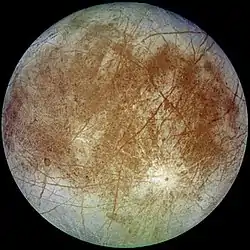 |
3.122 | 4.800e22 | 15 | 3,010 | Jupitermond |
| 16 | Triton[1] | .jpg.webp) |
2.707 | 2.14e22 | 16 | 2,050 | Neptunmond |
| 17 | (134340) Pluto[1] | 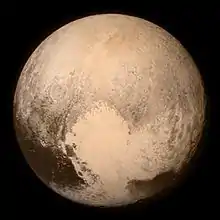 |
2.376 | 1.303e22 | 18 | 1,854 | Zwergplanet (TNO); bis 2006: 9. Planet |
| 18 | (136199) Eris[2][3][4] | 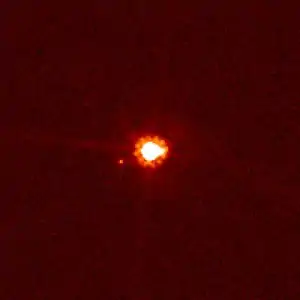 |
2.326 | 1.67e22 | 17 | 2,52 | Zwergplanet (TNO) |
| 19 | (136108) Haumea[5][6] |  |
ca. 2.100 × 1.680 × 1.070 | 4.01e21 | 19 | ca. 2 | Zwergplanet (TNO) |
| 20 | Titania[1] |  |
1.578 | 3.42e21 | 20 | 1,66 | Uranusmond |
| 21 | Rhea[1] |  |
1.527 | 2.31e21 | 23 | 1,24 | Saturnmond |
| 22 | Oberon[1] | 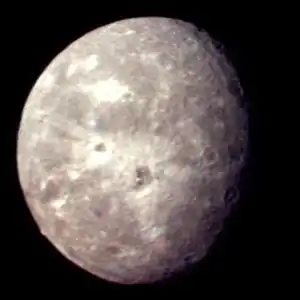 |
1.523 | 2.88e21 | 22 | 1,56 | Uranusmond |
| 23 | Iapetus[1] | 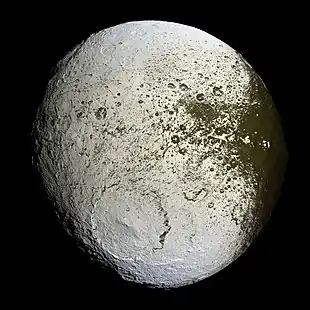 |
1.469 | 1.81e21 | 24 | 1,09 | Saturnmond |
| 24 | (136472) Makemake[7][8][9] |  |
1.430 | 3.1e21 | 21 | ca. 2 | Zwergplanet (TNO) |
| 25 | (225088) Gonggong[10] | .png.webp) |
1.230 | 1.75e21 | 25 | 1,75 | TNO |
| 26 | Charon[1] |  |
1.212 | 1.586e21 | 26 | 1,70 | Plutomond (TNO) |
| 27 | Umbriel[1] | .jpg.webp) |
1.169 | 1.22e21 | 29 | 1,46 | Uranusmond |
| 28 | Ariel[1] | .jpg.webp) |
1.158 | 1.29e21 | 28 | 1,59 | Uranusmond |
| 29 | Dione[1] |  |
1.123 | 1.10e21 | 30 | 1,48 | Saturnmond |
| 30 | (50000) Quaoar[11][12] |  |
1.120 | 1.4e21 | 27 | ca. 2 | TNO |
| 31 | Tethys[1] | 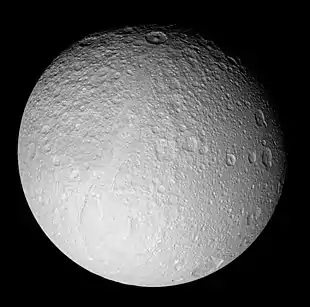 |
1.061 | 6.18e20 | 35 | 0,985 | Saturnmond |
| 32 | (90377) Sedna[13][A 1] |  |
995 | 1.0e21 | 31 | ca. 2 | TNO |
| 33 | (307261) 2002 MS4[14][A 2] |  |
934 | 8.5e20 | 33 | ca. 2 | TNO |
| 34 | (1) Ceres[1][15] | _(cropped).jpg.webp) |
963 × 891 | 9.393e20 | 32 | 2,162 | Zwergplanet (Asteroidengürtel) |
| 35 | (90482) Orcus[16][17] |  |
917 | 6.3e20 | 34 | 1,53 | TNO |
| 36 | (120347) Salacia[17] | 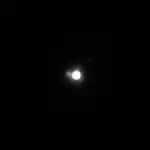 |
846 | 4.9e20 | 36 | 1,50 | TNO |
| 37 | (208996) 2003 AZ84[18][A 3] | 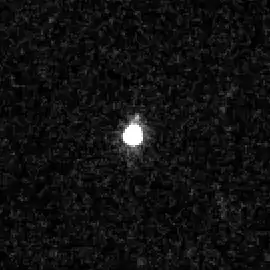 |
ca. 940 × 766 × 490 | 2.0e20 | 42 | 0,87 | TNO |
| 38 | (55565) 2002 AW197[19][A 4] | 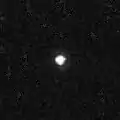 |
768 | 2.8e20 | 37 | ca. 1.2 | TNO |
| 39 | (174567) Varda[20][21] | 756 | 2.66e20 | 38 | ca. 1,2 | TNO | |
| 40 | (532037) 2013 FY27[22][A 5] | 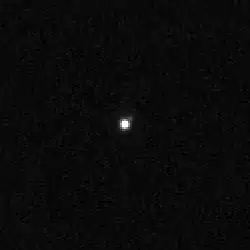 |
742 | 2.6e20 | 39 | ca. 1.2 | TNO |
| 41 | (90568) 2004 GV9[14][A 6] | 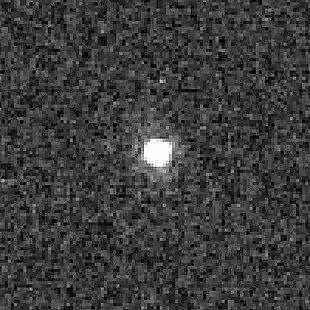 |
680 | 2.0e20 | 42 | ca. 1.2 | TNO |
| 42 | (145452) 2005 RN43[14][A 7] |  |
679 | 2.0e20 | 42 | ca. 1.2 | TNO |
| 43 | (523794) 2015 RR245[23][A 8] | 670 | 1.9e20 | 45 | ca. 1.2 | TNO | |
| 44 | (55637) 2002 UX25[16][24] |  |
665 | 1.25e20 | 50 | 0,82 | TNO |
| 45 | (20000) Varuna[25][26][A 9] |  |
654 | 1.45e20 | 46 | 0,99 | TNO |
| 46 | (229762) Gǃkúnǁʼhòmdímà[27][28] | 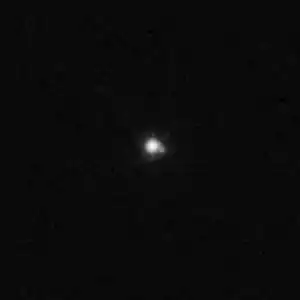 |
642 | 1.36e20 | 47 | 1,04 | TNO |
| 47 | 2010 RF43[29][A 10] | 636 | 1.3e20 | 48 | ca. 1 | TNO | |
| 48 | 2014 UZ224[30][A 11] |  |
635 | 1.3e20 | 48 | ca. 1 | TNO |
| 49 | (28978) Ixion[31][A 12] | 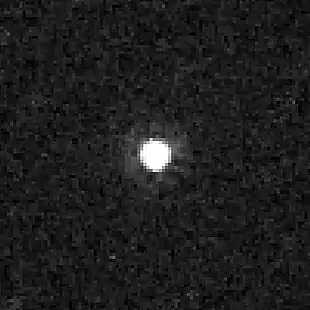 |
617 | 1.2e20 | 51 | ca. 1 | TNO |
| 50 | (278361) 2007 JJ43[32][A 13] | 610 | 1.2e20 | 52 | ca. 1 | TNO |
Weitere Objekte (Auswahl)
Die nachfolgenden Objekte gehören nicht zu den 50 größten Objekten im Sonnensystem. Die Asteroiden Pallas und Vesta zählen aufgrund ihrer hohen Dichte nach heutigem Wissensstand zu den 50 massereichsten Objekten im Sonnensystem, ihr Durchmesser ist jedoch zu klein.
| Rang Ø | Name | Bild | Durchmesser (km) |
Masse (kg) |
Rang Masse | Dichte (g/cm³) |
Objekttyp |
|---|---|---|---|---|---|---|---|
| - | (2) Pallas[1][33] |  |
582 × 556 × 500 | 2.05e20 | 41 | 2,57 | Asteroid |
| - | (4) Vesta[1][34] | 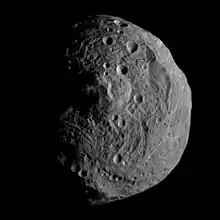 |
569 × 555 × 458 | 2.59e20 | 40 | 3,456 | Asteroid |
| - | Enceladus[1] | .jpg.webp) |
504 | 1.08e20 | - | 1,61 | Saturnmond |
| - | Miranda[1] | 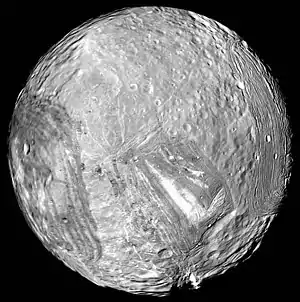 |
471 | 6.6e19 | - | 1,20 | Uranusmond |
| - | (10) Hygiea[33] | 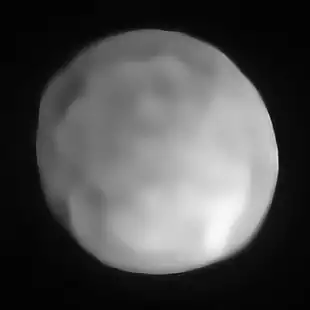 |
530 × 407 × 370 | 9e19 | - | 2,08 | Asteroid |
| - | Proteus[1] |  |
440 × 416 × 404 | 5.0e19 | - | ca. 1.3 | Neptunmond |
| - | Mimas[1] | 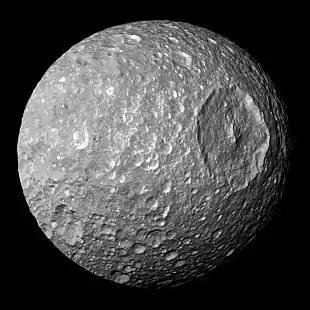 |
397 | 3.79e19 | - | 1,15 | Saturnmond |
| - | Nereid[1] |  |
340 | 3e19 | - | ca. 1.5 | Neptunmond |
| - | (52) Europa[33] | 362 × 302 × 252 | 2e19 | - | 1,57 | Asteroid | |
| - | (704) Interamnia[33] | 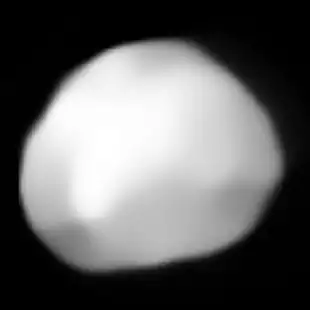 |
349 × 339 × 274 | 4e19 | - | 2,29 | Asteroid |
| - | (511) Davida[33] |  |
357 × 294 × 231 | 4e19 | - | 2,97 | Asteroid |
| - | Hyperion[1] | 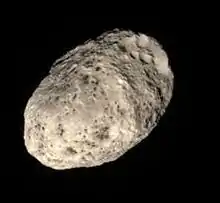 |
360 × 266 × 206 | 5.6e18 | - | 0,55 | Saturnmond |
| - | (15) Eunomia[33] | 357 × 255 × 212 | 3e19 | - | 3,14 | Asteroid | |
| - | (3) Juno[1][33] |  |
320 × 267 × 200 | 2e19 | - | 3,2 | Asteroid |
Siehe auch
Anmerkungen
- Die Masse von Sedna ergibt sich aus einer Abschätzung mit dem Durchmesser und einer für große TNO typischen angenommenen Dichte von 2 g/cm³
- Die Masse von 2002 MS4 ergibt sich aus einer Abschätzung mit dem Durchmesser und einer für große TNO typischen angenommenen Dichte von 2 g/cm³
- Die Masse von 2003 AZ84 ergibt sich aus einer Abschätzung mit dem Durchmesser und einer Dichte von 0,87 g/cm³
- Die Masse von 2002 AW197 ergibt sich aus einer Abschätzung mit dem Durchmesser und einer für vergleichbar große TNO typischen angenommenen Dichte von 1,2 g/cm³
- Die Masse von 2013 FY27 ergibt sich aus einer Abschätzung mit dem Durchmesser und einer für vergleichbar große TNO typischen angenommenen Dichte von 1,2 g/cm³
- Die Masse von 2004 GV9 ergibt sich aus einer Abschätzung mit dem Durchmesser und einer für vergleichbar große TNO typischen angenommenen Dichte von 1,2 g/cm³
- Die Masse von 2005 RN43 ergibt sich aus einer Abschätzung mit dem Durchmesser und einer für vergleichbar große TNO typischen angenommenen Dichte von 1,2 g/cm³
- Die Masse von 2015 RR245 ergibt sich aus einer Abschätzung mit dem Durchmesser und einer für vergleichbar große TNO typischen angenommenen Dichte von 1,2 g/cm³
- Die Masse von Varuna ergibt sich aus einer Abschätzung mit dem Durchmesser und einer Dichte von 0,99 g/cm³
- Die Masse von 2010 RF43 ergibt sich aus einer Abschätzung mit dem Durchmesser und einer für vergleichbar große TNO typischen angenommenen Dichte von 1 g/cm³
- Die Masse von 2014 UZ224 ergibt sich aus einer Abschätzung mit dem Durchmesser und einer für vergleichbar große TNO typischen angenommenen Dichte von 1 g/cm³
- Die Masse von Ixion ergibt sich aus einer Abschätzung mit dem Durchmesser und einer für vergleichbar große TNO typischen angenommenen Dichte von 1 g/cm³
- Die Masse von 2007 JJ43 ergibt sich aus einer Abschätzung mit dem Durchmesser und einer für vergleichbar große TNO typischen angenommenen Dichte von 1 g/cm³
Einzelnachweise
- David R. Williams: Planetary Fact Sheets. Goddard Space Flight Center, abgerufen am 28. März 2020 (englisch).
- M. Brown, E. Schaller: The Mass of Dwarf Planet Eris. In: Science. Band 316, Nr. 5831, 15. Juni 2007, S. 1585, doi:10.1126/science.1139415, bibcode:2007Sci...316.1585B (hubblesite.org [PDF]).
- B. Sicardy u. a.: Size, density, albedo and atmosphere limit of dwarf planet Eris from a stellar occultation. In: EPSC Abstracts. Band 6, Oktober 2011, bibcode:2011epsc.conf..137S (copernicus.org [PDF]).
- Eris - in Depth. Abgerufen am 28. März 2020 (englisch).
- D. Ragozzine, M. E. Brown: Orbits and Masses of the Satellites of the Dwarf Planet Haumea. In: The Astronomical Journal. Band 137, Nr. 6, 2009, S. 4766–4776, doi:10.1088/0004-6256/137/6/4766, arxiv:0903.4213, bibcode:2009AJ....137.4766R.
- E. T. Dunham, S. J. Desch, L. Probst: Haumea's Shape, Composition, and Internal Structure. In: The Astrophysical Journal. Band 877, Nr. 1, April 2019, S. 11, doi:10.3847/1538-4357/ab13b3, arxiv:1904.00522, bibcode:2019ApJ...877...41D.
- 30 verschiedene Autoren: Albedo and atmospheric constraints of dwarf planet Makemake from a stellar occultation. In: Nature. Band 491, Nr. 7425, 2012, S. 566–569, PMID 23172214, bibcode:2012Natur.491..566O. (ESO 21 November 2012 press release: Dwarf Planet Makemake Lacks Atmosphere)
- M.E. Brown: On the size, shape, and density of dwarf planet Makemake. In: The Astrophysical Journal Letters. Band 767, Nr. 1, 25. März 2013, S. L7, doi:10.1088/2041-8205/767/1/L7, arxiv:1304.1041, bibcode:2013ApJ...767L...7B.
- Alex Parker et al.: The Mass, Density, and Figure of the Kuiper Belt Dwarf Planet Makemake. In: American Astronomical Society, DPS meeting #50, id.509.02. Oktober 2018, bibcode:2018DPS....5050902P.
-
The mass and density of the dwarf planet (225088) 2007 OR10
author. In: Icarus. Band 334, 2019, S. 3–10, doi:10.1016/j.icarus.2019.03.013, arxiv:1903.05439, bibcode:2018DPS....5031102K.
Initial publication at the American Astronomical Society DPS meeting #50, with the publication ID 311.02 - Braga-Ribas u. a.: The Size, Shape, Albedo, Density, and Atmospheric Limit of Transneptunian Object (50000) Quaoar from Multi-chord Stellar Occultations. In: The Astrophysical Journal. Band 773, 22. Juli 2013, S. 26, doi:10.1088/0004-637X/773/1/26, bibcode:2013ApJ...773...26B.
- Ko Arimatsu, Ryou Ohsawa, George L. Hashimoto, Seitaro Urakawa, Jun Takahashi, Miyako Tozuka: New constraint on the atmosphere of (50000) Quaoar from a stellar occultation. In: The Astronomical Journal. Band 158, Nr. 6, Dezember 2019, S. 7, doi:10.3847/1538-3881/ab5058, arxiv:1910.09988, bibcode:2019AJ....158..236A.
- "TNOs are Cool": A survey of the trans-Neptunian region. VII. Size and surface characteristics of (90377) Sedna and 2010 EK139. In: Astronomy & Astrophysics. Band 541, 2012, S. L6, doi:10.1051/0004-6361/201218874, arxiv:1204.0899, bibcode:2012A&A...541L...6P.
- E. Vilenius, C. Kiss, M. Mommert: "TNOs are Cool": A survey of the trans-Neptunian region VI. Herschel/PACS observations and thermal modeling of 19 classical Kuiper belt objects. In: Astronomy & Astrophysics. Band 541, 2012, S. A94, doi:10.1051/0004-6361/201118743, arxiv:1204.0697, bibcode:2012A&A...541A..94V.
- 1 Ceres. Jet Propulsion Laboratory, abgerufen am 12. April 2020.
- S. Fornasier, E. Lellouch, T. Müller, P.: TNOs are Cool: A survey of the trans-Neptunian region. VIII. Combined Herschel PACS and SPIRE observations of 9 bright targets at 70–500 µm. In: Astronomy & Astrophysics. Band 555, 2013, S. A92, doi:10.1051/0004-6361/201321329, arxiv:1305.0449, bibcode:2013A&A...555A..15F.
- Mutual Orbit Orientations of Transneptunian Binaries. In: Icarus. 2019, ISSN 0019-1035, doi:10.1016/j.icarus.2019.03.035 (author=W. M. Grundy, K. S. Noll, H. G. Roe, M. W. Buie, S. B. Porter, A. H. Parker, D. Nesvorný, S. D. Benecchi, D. C. Stephens, C. A. Trujillo Online [PDF]).
- A. Dias-Oliveira et al.: Study of the Plutino Object (208996) 2003 AZ84 from Stellar Occultations: Size, Shape, and Topographic Features. In: The Astronomical Journal. Band 154, Nr. 1, S. 13, doi:10.3847/1538-3881/aa74e9, arxiv:1705.10895, bibcode:2017AJ....154...22D.
- E. Vilenius, C. Kiss, T. Müller, M. Mommert, P. Santos-Sanz, A. Pál, J. Stansberry, M. Mueller, N. Peixinho, E. Lellouch, S. Fornasier, A. Delsanti, A. Thirouin, J. L. Ortiz, R. Duffard, D. Perna, F. Henry: "TNOs are Cool": A survey of the trans-Neptunian region. X. Analysis of classical Kuiper belt objects from Herschel and Spitzer observations. In: Astronomy and Astrophysics. Band 564, April 2014, S. 18, doi:10.1051/0004-6361/201322416, arxiv:1403.6309, bibcode:2014A&A...564A..35V.
- W. M. Grundy, S. B. Porter, S. D. Benecchi, H. G. Roe, K. S. Noll, C. A. Trujillo, A. Thirouin, J. A. Stansberry, E. Barker, H. F. Levison: The mutual orbit, mass, and density of the large transneptunian binary system Varda and Ilmarë. In: Icarus. Band 257, September 2015, S. 130–138, doi:10.1016/j.icarus.2015.04.036, arxiv:1505.00510, bibcode:2015Icar..257..130G (Online [PDF]).
- The stellar occultation by the TNO (174567) Varda of September 10, 2018: size, shape and atmospheric constraints. In: European Planetary Science Congress DPS Joint Meeting 2019. Band 13, September 2019 (Online [PDF]).
- Scott Sheppard, Yanga Fernandez, Arielle Moullet: The Albedos, Sizes, Colors and Satellites of Dwarf Planets Compared with Newly Measured Dwarf Planet 2013 FY27. In: The Astronomical Journal. Band 156, Nr. 6, 6. September 2018, S. 270, doi:10.3847/1538-3881/aae92a, arxiv:1809.02184, bibcode:2018AJ....156..270S.
- M. Bannister u. a.: OSSOS: IV. Discovery of a dwarf planet candidate in the 9:2 resonance with Neptune. In: The Astronomical Journal. Band 152, Nr. 6, 23. Juli 2016, S. 212, 8, doi:10.3847/0004-6256/152/6/212, arxiv:1607.06970, bibcode:2016AJ....152..212B (core.ac.uk [PDF]).
- M.E. Brown: The density of mid-sized Kuiper belt object 2002 UX25 and the formation of the dwarf planets. In: The Astrophysical Journal Letters. Band 778, Nr. 2, 2013, S. L34, doi:10.1088/2041-8205/778/2/L34, arxiv:1311.0553, bibcode:2013ApJ...778L..34B.
- E. Lellouch, R. Moreno, T. Müller, S. Fornasier, P. Sanstos-Sanz, A. Moullet, M. Gurwell, J. Stansberry, R. Leiva, B. Sicardy, B. Butler, J. Boissier: The thermal emission of Centaurs and Trans-Neptunian objects at millimeter wavelengths from ALMA observations. In: Astronomy & Astrophysics. Band 608, Dezember 2017, S. A45, doi:10.1051/0004-6361/201731676, arxiv:1709.06747, bibcode:2017A&A...608A..45L.
- P. Lacerda, D. Jewitt: Densities Of Solar System Objects From Their Rotational Lightcurve. In: The Astronomical Journal. Band 133, Nr. 4, 2006, S. 1393–1408, doi:10.1086/511772, arxiv:astro-ph/0612237, bibcode:2007AJ....133.1393L.
- Ortiz, Sicardy, Camargo & Braga-Ribas: The Transneptunian Solar System. Hrsg.: Prialnik, Barucci & Young. Elsevier, 2019, Stellar Occultations by Transneptunian Objects: From Predictions to Observations and Prospects for the Future.
- W. M. Grundy, K. S. Noll, W. M. Buie, S. D. Benecchi, D. Ragozzine, H. G. Roe: The mutual orbit, mass, and density of transneptunian binary Gǃkúnǁ'hòmdímà (229762 2007 UK126). In: Icarus. Band 334, Dezember 2018, S. 30–38, doi:10.1016/j.icarus.2018.12.037 (englisch, Online [PDF]).
- LCDB Data for (2010+RF43). Asteroid Lightcurve Database (LCDB). Abgerufen am 23. Februar 2018.
- D. W. Gerdes, M. Sako, S. Hamilton, K. Zhang, T. Khain, J. C. Becker: Discovery and Physical Characterization of a Large Scattered Disk Object at 92 AU. In: The Astrophysical Journal Letters. Band 839, Nr. 1, April 2017, S. 7, doi:10.3847/2041-8213/aa64d8, arxiv:1702.00731, bibcode:2017ApJ...839L..15G.
- E. Lellouch, P. Santos-Sanz, P. Lacerda, M. Mommert, R. Duffard, J. L. Ortiz, T. G. Müller, S. Fornasier, J. Stansberry, Cs. Kiss, E. Vilenius, M. Mueller, N. Peixinho, R. Moreno, O. Groussin, A. Delsanti, A. W. Harris: "TNOs are Cool": A survey of the trans-Neptunian region. IX. Thermal properties of Kuiper belt objects and Centaurs from combined Herschel and Spitzer observations. In: Astronomy & Astrophysics. Band 557, September 2013, S. 19, doi:10.1051/0004-6361/201322047, arxiv:1202.3657, bibcode:2013A&A...557A..60L (Online [PDF]).
- A. Pál u. a.: Pushing the limits: K2 observations of the trans-Neptunian objects 2002 GV31 and (278361) 2007 JJ43. In: The Astrophysical Journal Letters. Band 804, Nr. 2, 12. Mai 2015, S. L45, doi:10.1088/2041-8205/804/2/L45, arxiv:1504.03671, bibcode:2015ApJ...804L..45P.
- James Baer, Steven Chesley, Robert D. Matson: Astrometric masses of 26 asteroids and observations on asteroid porosity. In: The Astronomical Journal. Band 141, Nr. 5, 2011, doi:10.1088/0004-6256/141/5/143, bibcode:2011AJ....141..143B.
- C. T. Russell: Dawn at Vesta: Testing the Protoplanetary Paradigm. In: Science. Band 336, Nr. 6082, 2012, S. 684–686, doi:10.1126/science.1219381, PMID 22582253, bibcode:2012Sci...336..684R (Online [PDF]). phyast.pitt.edu (PDF; 713 kB)